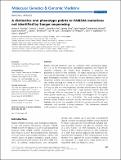Mostrar el registro sencillo del ítem
A distinctive oral phenotype points to FAM20A mutations not identified by Sanger sequencing
| dc.creator | Poulter, James A. | |
| dc.creator | Smith, Claire E. L. | |
| dc.creator | Murillo Knudsen, Gina | |
| dc.creator | Silva de la Fuente, Sandra Maria | |
| dc.creator | Feather, Sally | |
| dc.creator | Howell Ramírez, Marianella | |
| dc.creator | Crinnion, Laura | |
| dc.creator | Bonthron, David | |
| dc.creator | Carr, Ian M. | |
| dc.creator | Watson, Christopher M. | |
| dc.creator | Inglehearn, Chris F. | |
| dc.creator | Mighell, Alan J. | |
| dc.date.accessioned | 2018-07-24T14:49:39Z | |
| dc.date.available | 2018-07-24T14:49:39Z | |
| dc.date.issued | 2015-10-04 | |
| dc.identifier.citation | https://onlinelibrary.wiley.com/doi/abs/10.1002/mgg3.164 | |
| dc.identifier.issn | 2324-9269 | |
| dc.identifier.uri | https://hdl.handle.net/10669/75266 | |
| dc.description.abstract | Biallelic FAM20A mutations cause two conditions where Amelogenesis Imperfecta (AI) is the presenting feature: Amelogenesis Imperfecta and Gingival Fibromatosis Syndrome; and Enamel Renal Syndrome. A distinctive oral phenotype is shared in both conditions. On Sanger sequencing of FAM20A in cases with that phenotype, we identified two probands with single, likely pathogenic heterozygous mutations. Given the recessive inheritance pattern seen inall previous FAM20A mutation-positive families and the potential for renal disease, further screening was carried out to look for a second pathogenic allele. Reverse transcriptase-PCR on cDNA was used to determine transcript levels. CNVseq was used to screen for genomic insertions and deletions. In one family, FAM20AcDNA screening revealed only a single mutated FAM20A allele with the wild-type allele not transcribed. In the second family, CNV detection by whole genome sequencing (CNVseq) revealed a heterozygous 54.7 kb duplication encompassing exons 1 to 4 of FAM20A. This study confirms the link between biallelic FAM20A mutations and the characteristic oral phenotype. It highlights for the first time examples of FAM20A mutations missed by the most commonly used mutation screening techniques. This information informed renal assessment and ongoing clinical care. | es_ES |
| dc.description.sponsorship | Medical Research Council/[MR/LO1629X/1]/MRC/Inglaterra | es_ES |
| dc.description.sponsorship | The Sir Jules Thorn Award for Biomedical Research/[JTA/09]//Inglaterra | es_ES |
| dc.description.sponsorship | Wellcome Trust/[093113]//Inglaterra | es_ES |
| dc.language.iso | en_US | es_ES |
| dc.source | Molecular Genetics & Genomic Medicine,vol.3(6),pp.543-549 | es_ES |
| dc.subject | Amelogenesis imperfecta | es_ES |
| dc.subject | CNVseq | es_ES |
| dc.subject | FAM20A | es_ES |
| dc.subject | Enamel renal syndrome | es_ES |
| dc.title | A distinctive oral phenotype points to FAM20A mutations not identified by Sanger sequencing | es_ES |
| dc.type | artículo original | |
| dc.identifier.doi | 10.1002/mgg3.164 | |
| dc.description.procedence | UCR::Vicerrectoría de Investigación::Unidades de Investigación::Ciencias Básicas::Centro de Investigación en Biología Celular y Molecular (CIBCM) | es_ES |
| dc.description.procedence | UCR::Vicerrectoría de Docencia::Salud::Facultad de Odontología | es_ES |
Ficheros en el ítem
Este ítem aparece en la(s) siguiente(s) colección(ones)
-
Biología [1635]


